
WARNINGS / SAFETY PRECAUTIONS
2
Warning
To avoid any risk of personal injury, material damage or incorrect use of the appliance, be sure to observe the
following safety precautions. (After reading these owner’s instructions, please keep them in a safe place for
reference.) Remember to hand them over to any subsequent owner.
Indicates that a danger of death or
serious injury exists.
Caution
Indicates that a risk of personal
injury or material damage exists.
Warning
Do not plug several appliances into the same socket.
• This could cause overheating and the risk of fire.
Keep the power plug away from the rear of the
refrigerator/freezer.
• A damaged power plug may cause fire due to overheating.
Do not directly spray water inside or outside the
refrigerator/freezer.
• There is a risk of fire or electric shock.
Do not spray inflammable gas near the
refrigerator/freezer.
• There is a risk of explosion or fire.
Do not bend the power cord excessively or place heavy
articles on it.
This constitutes a fire hazard.
If the power cord is
damaged, have it replaced immediately by the
manufacturer or its service agent.
Do not insert the power plug with wet hands.
• You may receive an electric shock.
Do not put a container filled with liquid on top of the
appliance.
• If the water spills on to any electrical parts, it may lead to
fire or electric shock.
Do not install the refrigerator/freezer in a damp place,
where it may come into contact with water.
• Incorrect insulation of the electrical parts may cause an
electric shock or fire.
Do not store volatile and inflammable substances in the
refrigerator.
• The storage of benzene, thinner, alcohol, ether, LP gas or
other such substances may cause an explosion.
Do not disassemble, repair or alter the appliance.
• It may cause fire or abnormal operation, which may lead to
injury.
Pull the power plug out of the socket before replacing
the interior light in the refrigerator.
• Otherwise, there is a risk of electric shock.
Be sure to ground the appliance.
• Otherwise, it may cause material damage or electric shock.
If you wish to dispose of the refrigerator/freezer, throw it
away after removing the door or its seals.
• In this way, it is not possible for a child to remain trapped
inside it.
• Keep ventilation openings in the appliance enclosure or
mounting structure clear of obstruction.
• Do not use mechanical devices or any other means to
accelerate the defrosting process, other than those
recommended by the manufacturer.
• Do not damage the refrigerant circuit.
• Do not use electrical appliances inside the
refrigerator/freezer, unless they are of a type
recommended by the manufacturer.
Warning

















